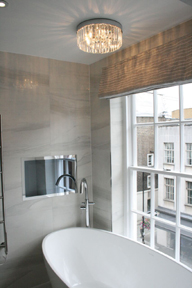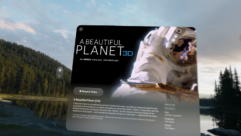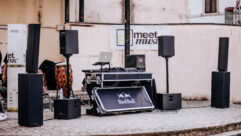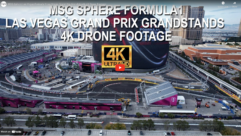
SVC Podcast – Show Notes – Show 151-1
In this edition of the SVC Podcast, SVC Contributing Editor Bennett Liles talks with Bryan Vint of Ugot Simple Home Control about the installation of a complete AV, lighting and access control system in London’s famous Apple Building, site of the Beatles’ Apple Boutique in the late ‘60’s. Bryan outlines the selection of Elan Home Systems for AV control and Rako for lighting control. He details the connection techniques used and discusses the specific components including waterproof televisions.
For Part 2
Links of interest:
Download Podcast Here:
https://s3.amazonaws.com/nb-svc/public/public/151-1_Apple_Bldg_Ugot_Brya…
From Sound & Video Contractor Magazine, this is the SVC Podcast with Bryan Vint of Ugot Simple Home Control. Show notes for the podcast are on the web site of Sound & Video Contractor Magazine at svconline.com.
The famous Apple Building was home to the Beatles’ Apple Boutique but now some 50 years later it has become a group of luxury apartments fitted out with Elan AV control and Rako lighting. Bryan Vint is joining us from London to tell us how his company, Ugot Simple Home Control installed the whole system and got it working, coming up next on the SVC Podcast.
Bryan, we’re glad to have you joining us on the SVC Podcast from Ugot Simple Home Control and I believe you’re in London or the London area.
We’re just south of London, actually, but we work an awful lot in London. It’s a hub for the sort of projects that we do.
Okay. Tell me a little about Ugot Simple Home Control. What sort of projects do you do? Is it mainly residential or is it commercial work, too?
The company is 10 years old. It’s owned by my wife and I. There’s six people in the company at the moment. And we mostly do domestic products, multi-room AV with lighting control almost on every single project. Heating control is becoming more a part of what we do. We do home cinema and CCTV and other control systems as well. [Timestamp: 1:33]
And we’re talking about an installation on the Apple Building I believe it’s called, the home of the Beatles’ Apple Boutique back in the late ‘60’s. But now it has been turned into luxury apartments and they needed AV control, lighting and building access systems installed so they called you. Why was Ugot Simple Home Control well positioned to take on this particular project?
When we took on the project we’d been working in the industry for several years and so we had a wide range of experience in multi-room AV systems and so on. But specifically we’d worked with this developer for a couple of years and in fact had done a very similar project for them the previous year in Chapter Street, which is just outside Chelsea in London. So it was something that although we had to change the product – we’d originally used Opus for the previous product, which was a system available here in the UK at the time, but then wasn’t available when we were looking at this new project. And the obvious choice for us was Elan because it did everything that we wanted it to do and it was a simple move for us from one product to the other. [Timestamp: 2:39]
A lot of our listeners are familiar with Elan control systems and you also did Rako lighting for lighting control?
Absolutely. So there’s a company based in the UK called Rako Controls. They’re based down in Kent, so about 100 miles from where we are here. And they came into the market not long before we did, I think, 10-odd years ago, offering at the time an almost wireless lighting system with dimmers that effectively had an RF interface and went in line rather than being centralized or so on. So that changed the market at the time. They’ve since gone into a wide system as well and it’s very flexible, very cost-effective, and very robust so it suits us down to the ground. And it works seamlessly with the Elan system. [Timestamp: 3:30]
And I would guess that you had previous similar projects using the same installation techniques or tricks of the trade. This was not cutting edge or anything totally new for you?
No, certainly not for us. It’s not cutting edge or new. We had to think about the system and the building itself, obviously, and the different rooms. The apartments in the living area side of things were quite compact so it’s very important that we installed a system that would not take up the space, obviously with sky boxes everywhere and so on. So we had to think very carefully about that. [Timestamp: 4:03]
Did the building’s location or architecture present any special challenges? I know that the Ministry of Antiquities if you’re working in a very old or historic place, can have a lot of sticky rules but were there any restrictions or challenges on the building itself?
There was nothing architectural, no, because the building had been used commercially so much of the building had been stripped out. London – central London – always presents a problem due to parking restrictions and the traffic and so on, so getting vehicles close enough to be able to offload equipment without getting it moved on by a parking official is always a concern. But the developers had their own electricians carry out the cabling so they took care of most of the difficult side of things as far as avoiding any building regulations were concerned. [Timestamp: 4:53]
So when you got in on this and had a look at the place, what was your first impression when you saw the apartments or the plans and realized what was going to be involved?
Initially it was the use of space. As I said a second ago, the rooms are of a fair size. They had to be multi-functional and therefore we had to consider how the audio and the video and even the lighting would work in a multifunctional area. For example, the living area is a living area, a dining area and the kitchen and the kitchen rolls away effectively; it disappears behind. It’s very clever the way it’s done, but it’s very compact. Obviously we needed to think about how people would be living in the property and how they would be using the system. So how would the TV audio work in the living area if someone else wanted to do something in the kitchen area and so on. So it was a lot to think about. [Timestamp: 5:45]
So what are the capabilities of the system you put in there, obviously not just turning TVs on and off? There are other things that are controlled and managed by the system as well.
Absolutely. So the show apartment we put full HD distribution system in so there were four TV’s, a Y-Storm 4×4 matrix. Obviously the music side of things, which had various input sources – an audio server I think went into each one of the properties – and the lighting, we had lighting control in each room. We wanted to do the lighting as well, but the developer was very keen on what was then new to us, the Nest heating control system. So we didn’t integrate that, but being an apartment in a group of apartments in London there was the need for a door entry system as well. So it was a lot of integration that went through the system. [Timestamp: 6:37]
So not AV alone but actually a security aspect to it.
Precisely. Absolutely. That will pop up onto the touchscreen. CCTV wires will pop up on the touchscreens, of course, and the door entry system, in fact, sat alone on this project, but it was in the building as well. [Timestamp: 6:53]
And something that got my attention in reading about this one. There were water-proof televisions? Why were those specified?
That’s a very good question. It was one of those things that we discussed at length with the developers and these went into the on-suite bathrooms to the master bedrooms. What the developer was looking for was, if you like, an oasis; somewhere that busy executives in London could go and sit and look out the window and enjoy relaxing, watching TV because the master effectively sat right in front of a window – a full-height window. So it’s quite a stunning place to be and the decision was that due to the level of special occasion for the property itself and the sort of people that the developer was trying to attract, a waterproof TV would be a really nice addition. [Timestamp: 7:41]
Well, that would be something to see. I don’t think I’ve seen a water-proof TV before. Was it actually manufactured that way or was it just a TV that you specially enclosed in something that was retro-fitted?
There is a specific TV that effectively fits into the wall and is sealed into the wall so that it’s completely waterproof. We’ve done actually quite a few of them, different makes and models. Aquavision is the most common in the UK. It’s just a piece of luxury to be honest with you. We’ve never had – touch wood – we’ve never had one go wrong in 10 years. [Timestamp: 8:15]
Well, that’s a good record. Now the overall building access sounds like a big job in terms of places you had to reach. What took the most time on this?
What took the most time? I think because of the installation itself and the way the developer needed to work in order to get things done, we ended up doing it piecemeal, if you like. So rather than going in and doing an apartment and then the next apartment being finished and doing that apartment, we had to go back and do bits and pieces every time. So we were moving about between apartments and obviously having to keep records of what we were doing and where we were doing it on the programming side of things. [Timestamp: 8:53]
And which one of the Elan system controllers was used for this setup? Which actual hardware did you use?
The Elan controller was the HC-4 and that was integrated with the S-86 and the M-86 amplifiers.
Okay. And these are connected, what do they use? Contact closures, infrared or Ethernet?
It’s over IP.
Okay, and you have a whole IP network in each apartment.
Absolutely. Correct, yes.
What are the sensory capabilities of this system? What conditions can it detect and tell the owner? Obviously, you don’t want to flood the client with too much information.
When we specified the systems because they were looking to sell the projects. We were asked to put in a system that could then be added to. So the clever side of it, if you like, is the lighting with some light sensing in there and obviously with scene setting and so on. Adding to the system was going to come later, so things like adding in a further for the people who own the properties and so on. But what actually happened in the end was the whole building was sold to one person – one company – and they now rent out the apartments. So the follow-up where we could have added much more to the systems actually hasn’t happened, unfortunately. [Timestamp: 10:04]
That was a very highly-publicized event when those apartments opened and people got to see the inside and how all of the control systems work. We’ll get more into the technical details in Part 2 but thanks for getting us started on this one. It’s Bryan Vint from Ugot Simple Home Control and London’s Apple Building with newly fitted out apartments. Thanks, Bryan. It’s been good having you with us.
Thank you for having me. It’s an absolute pleasure.
Thank you for being here with us for the SVC Podcast with Bryan Vint. Show notes are on the website of Sound & Video Contractor Magazine at svconline.com. Be back with us next week for Part 2 when Bryan will tell us about the Elan in-wall touch panels and the Rako lighting system. That’s on the next SVC Podcast.










